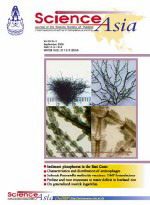ThaiScience
ThaiScience
SCIENCE ASIA
Volume 47, No. 02, Month APRIL, Year 2021, Pages 228 - 234
Soil aggregate stability under different land-use types in north china plain
Lixia Zhu, Lili Li, Tianxue Liu
Abstract Download PDF
Soil aggregate stability is a vital indicator for evaluating soil quality. Land-use types may affect size distribution and stability of soil aggregates via changing soil organic carbon content. This study was conducted to evaluate effects of long-term different land-use types on soil aggregates. Three land-use types (forestland, grassland, and cropland) were selected in Zhoukou City (Central China). Soil aggregates were assessed by both wet and dry sieving methods. Significant difference of mean weight diameter (MWD) was observed under different land-use types and sieving methods. In 0–20 cm layer, MWD ranged from 0.32 to 1.45 mm under wet sieving method, while it ranged from 3.43 to 6.32 mm under dry sieving method; in 20–40 cm layer, the MWD ranged from 0.66 to 1.15 mm and from 2.74 to 6.48 mm under wet and dry sieving methods, respectively. The MWD for the wet sieving method was lower than that under dry sieving method, which might indicate that the soil tended to suffer from erodibility. MWD under both sieving methods was the highest in forestland, suggesting that the forestland soil was more resistant to soil erosion. The positive correlation between MWD and soil organic carbon was significant under wet sieving method. These results showed that land-use types had significant effects on soil aggregates, and soil organic carbon was related to stability of soil aggregates. These results would help to provide guidance for alleviating soil erosion and promoting soil quality under different land-use types.
Keywords
land-use types, soil aggregate stability, wet sieving method, dry sieving methodSCIENCE ASIA
Published by : The Science Society of Thailand
Contributions welcome at : http://www.scienceasia.org/
